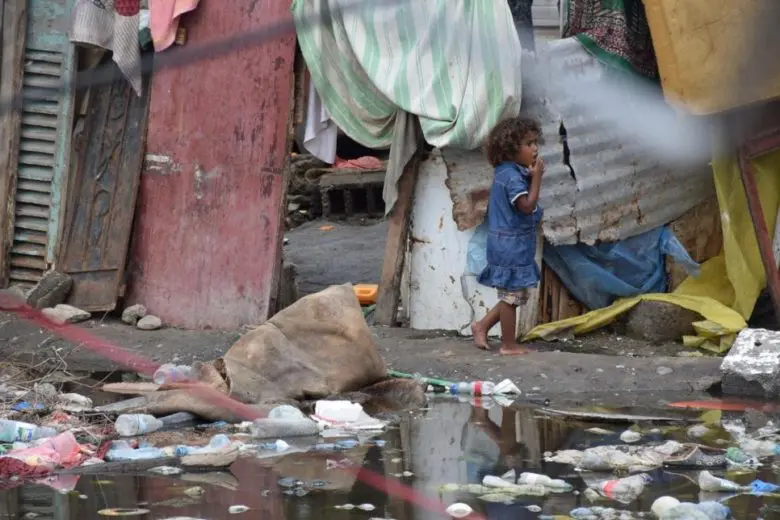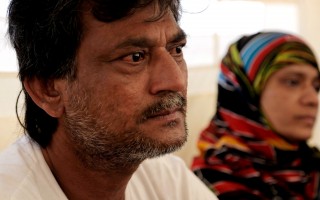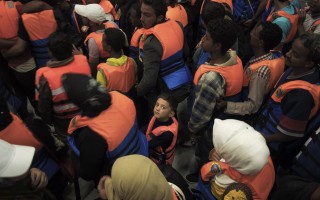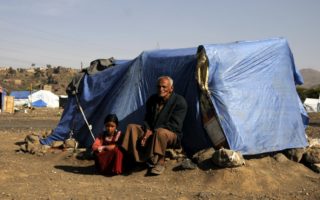
A child walks past flood water at a site for internally displaced people in Aden, Yemen, March 2020. © UNHCR/Essam Adduais
This is a summary of what was said by UNHCR spokesperson Andrej Mahecic – to whom quoted text may be attributed – at today’s press briefing at the Palais des Nations in Geneva.
An estimated 300,000 people in Yemen have lost their homes, crops, livestock and personal belongings in the last three months due to torrential rains and severe flash floods. Amongst the newly displaced are people were previously forced to flee their homes by the conflict. They are once again having to rebuild their lives and communities.
The most badly-hit areas include Marib, Amran, Hajjah, Al Hudaydah, Taizz, Lahj, Aden and Abyan governorates where floods have killed at least 148 people in the last two months alone. In Hababa, a sudden and catastrophic break of the Al-Roone dam led to the uncontrolled release of 250,000 cubic metres of water, affecting thousands of people in IDP sites in Al-Tahseen, Souq al-Lill and elsewhere.
Many of the internally displaced people (IDPs) displaced by the floods were already living in abject poverty, often in overcrowded, makeshift shelters made from plastic sheeting or mud which have been washed away or sustained significant damage. People are now being forced to shelter in mosques, schools or with relatives or live out in the open, in abandoned buildings, some of which are at risk of collapsing, or in whatever is left of their damaged homes.
Many were already struggling to survive, with little to no work opportunities and barely able to afford one meal for their families each day. Levels of desperation and despair are rising as the world’s worst humanitarian crisis plumbs to new depths.
UNHCR is deeply concerned that the displaced communities are extremely vulnerable to the COVID-19 pandemic, with many unable to practice social or physical distancing, access clean water for hand-washing or enact other measures to prevent transmission of the virus. The country’s health infrastructure is already badly damaged by years of conflict,
Thousands more may yet be impacted as the rainy season is expected to continue and the capacities of many dams, some of which are in poor condition due to neglect in recent years because of the conflict, are becoming increasingly overwhelmed. In Marib, the dam has reached the overflow level and is highly vulnerable to bursting if further extreme and extended rainfall overfills the reservoir. This would destroy the downstream irrigated area, where sites hosting thousands of people who have become internally displaced (IDPs) by the conflict are located, as well as the lower parts of Marib town.
UNHCR, the UN Refugee Agency, is rushing to provide emergency shelter support and core relief items such as blankets and mattresses to thousands of people, as well as counselling support to those struggling to cope with the loss of their homes and loved ones. Together with partners, we are engaging the displaced communities to raises awareness of COVID-19 protection and prevention measures.
However, our capacities continue to be constrained by severe underfunding. On current levels, our stocks of shelter and emergency relief items will run out in a matter of weeks, leaving with some of their most basic needs unmet. After more than five years of conflict, more than 80 per cent of Yemen’s total population requires humanitarian assistance. Close to 4 four million IDPs, returnees, refugees and asylum-seekers are now reliant on regular humanitarian aid to survive.
For more information on this topic, please contact:
- In Sana’a, Heba Kanso, kanso@unhcr.org, +967 71 222 5123
- In Amman, Rula Amin, aminr@unhcr.org, +962 790 04 58 49
- In Geneva, Charlie Yaxley, yaxley@unhcr.org, +41 795 808 702
- In New York, Kathryn Mahoney, mahoney@unhcr.org, +1 347 443 7646
Originally published by UNHCR on 21 August 2020





